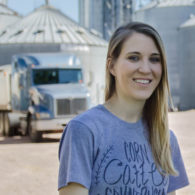Take-aways from September’s Ag & Animal Science Conference in Willmar, Minnesota
October 26, 2016
The Urgent Need to Manage Water & Communicate our Story
 By Sara Hewitt, Farmer, Ag Educator, & Marketing Director of Hewitt Drainage Equipment
By Sara Hewitt, Farmer, Ag Educator, & Marketing Director of Hewitt Drainage Equipment
PRINSCO CUSTOMER & GUEST BLOGGER
I recently attended the Ag and Animal Science Conference in Willmar, Minnesota, on the MinnWest Technology Campus. I wasn’t sure what to expect, but the caliber of speakers and attendees was very high, and all were dynamic leaders and contributors in the agriculture industry. I set my alarm for 5 a.m., filled my coffee mug, and pointed my Jeep towards Willmar.
The day opened with Mike Pearson, the host of “Market to Market” on Iowa Public Television. He discussed the cyclical nature of agriculture, and that every 30 years we see a boom – something that drives prices and brings solid profits. Mike pointed to livestock. We’ve already begun to see a global increase in protein consumption, and I agree with him that as other countries grow their population and income, an increase in protein purchases will happen. He emphasized that the United States’ ability to position itself for international trading will be key to the future success of our agricultural profits.
Mike also mentioned something interesting about water availability. He said that when it comes down to it, urban water needs will soon outpace agricultural production needs. We already see this taking place out in California. Companies and farms are shifting their production back to the Midwest where water availability isn’t as much of an issue. He said in the Midwest we have enough water and sometimes even too much, forcing us to deal with issues like run-off. What does that mean for current operations? It means there is more pressure than ever for farmers to properly manage water through a variety of methods and stay on top of new research around nutrient management.
Robert Saik, Keynote Speaker and Founder of Agri-Trend,® talked about the climate around GMO’s, food labeling, and fear as a motivator for consumer food purchases. He stressed that food paranoia is a first world problem and that the impact of people’s negative beliefs about food is greater than we think. According to Saik, choosing not to talk about what we are doing as farmers helps perpetuate the inaccurate, distorted food fears that are out there. We need to share why we are doing things on our farms. For example, we need to highlight our conservation efforts and explain why we install things like terraces, grass strips, and tile in our fields. We should be sharing the benefits of replacing old clay and cement tile in our fields, how we use GPS and other technologies to install it, and the benefits of water management systems in the first place.
I believe that if we need to do a better job of communicating what we do, we also need to do a better job of listening. We need to tune into what our consumers, legislators, county commissioners and key leaders are saying and come together to make communication a two-way street.
To me, that’s what this conference all boiled down to at the end of the day. Each speaker confirmed that we all need to listen, tell our story, talk to our elected officials, and educate about what is happening on our farms and why.
The Ag and Animal Science Conference should be on your calendar for next year if you haven’t attended before. The speakers were influential, energetic, and extremely relevant to the challenges facing the agriculture industry today.
Categories: Agriculture
